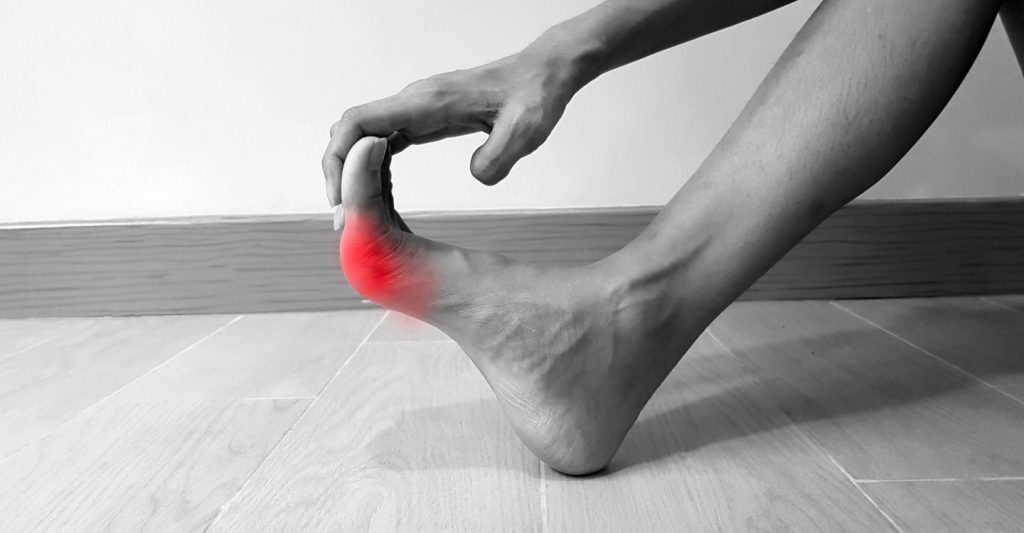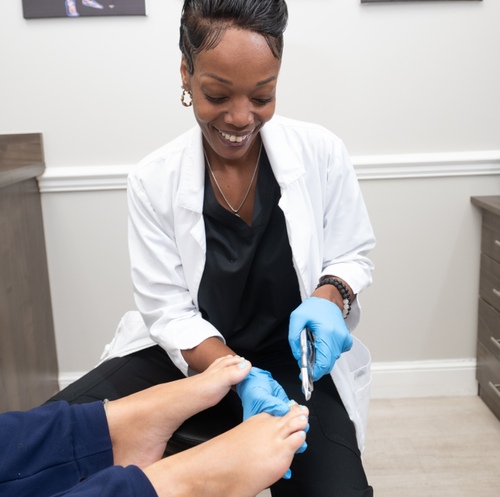Looking for a way to pamper your feet while addressing health concerns? A medical pedicure, or “medi-pedi,” offers the perfect blend of beauty and healthcare for your feet.
Unlike regular salon pedicures, medical pedicures are performed by healthcare professionals who can identify and address foot problems while providing cosmetic care.
These specialized treatments go beyond the surface beauty of traditional pedicures. They focus on proper nail trimming, callus removal, and addressing issues like ingrown toenails or fungal infections.
Medical pedicures combine cosmetic and medical foot care elements, making them ideal for diabetic patients, athletes, and anyone concerned about foot health.
These treatments help manage existing foot problems while detecting issues in their early stages, preventing more serious complications down the road.
Key Takeaways
- Medical pedicures provide both aesthetic improvement and preventative healthcare for your feet under the supervision of qualified professionals.
- Medi-pedis offer superior hygiene standards and can address specific foot conditions that traditional salon services cannot treat.
- Regular medical pedicures help maintain foot health between podiatry visits and can prevent common foot problems before they become serious.
What Exactly Is a Medi Pedicure?
A medi pedicure is a specialized foot care treatment combining medical expertise and aesthetic care.
It differs significantly from regular salon pedicures by focusing on both health and appearance.
The Purpose of a Medi Pedicure
A medi pedicure (also called a medical pedicure) aims to provide thorough foot care with a clinical approach. Unlike traditional pedicures, it focuses primarily on foot health rather than just aesthetics.
Approximately 15% of the global population is affected by fungal foot infections, highlighting the importance of proper foot hygiene.
These treatments bridge podiatry and basic nail care with a stronger emphasis on addressing medical concerns.
They’re performed in sterile environments using surgically sterilized instruments to ensure maximum hygiene and safety.
The primary goal is preventative care – identifying potential issues before they become serious problems.
Practitioners address conditions like:
- Ingrown toenails
- Fungal infections
- Calluses and corns
- Cracked heels
- Thick or deformed nails
Many services are waterless, reducing infection risks common in traditional salon foot baths.
The Science Behind a Medi Pedicure
Medical pedicures are grounded in podiatric medicine, with treatments based on foot anatomy and pathology. They’re typically performed by licensed podiatrists or specially trained medical professionals.
These specialists use professional-grade tools designed for precision work on toenails and skin. The sterile environment follows medical-grade sanitation protocols to prevent cross-contamination.
For cts with diabetes or circulation issues, practitioners apply evidence-based techniques that reduce injury risks.
They also use specialized creams and treatments formulated for specific skin conditions and nail disorders.
Modern medi pedicures may incorporate technologies like:
- Ultrasonic cleaning
- Laser therapy for fungal infections
- Specialized filing systems for thickened nails
- Medical-grade moisturizers and antiseptics
The approach is clinical but still provides the relaxation benefits associated with foot care.
Who Should Consider a Medi Pedicure?
Individuals with existing foot conditions benefit most from medical pedicures. This includes those with diabetes, who face higher risks from regular salon procedures due to potential cuts or infections.
People with sensitive skin or allergies appreciate the controlled environment and hypoallergenic products.
Athletes and active individuals find value in preventative care that addresses strain-related foot issues.
Seniors often benefit significantly, as aging affects nail thickness and foot health.
Anyone recovering from foot surgery or injury may be directed to these services as part of rehabilitation.
Even those without specific concerns might choose medi pedicures for their superior cleanliness and safety.
Regular treatments can help maintain optimal foot health and prevent common problems before they start.
The service is particularly valuable for those wearing orthopedic shoes or with limited mobility who struggle with self-care.
Key Benefits of a Medi Pedicure: More Than Just Pretty Feet
Medical pedicures offer substantial health advantages beyond cosmetic improvements. They provide specialized care that addresses both the appearance and wellness of feet.
Health and Hygiene First
Medical pedicures prioritize cleanliness and safety at a level far above traditional salon services. All tools used during a medi pedicure are adequately sterilized, significantly reducing the risk of infections in standard pedicure settings.
The treatments take place in a clinical environment rather than a spa, ensuring that professional-grade sanitation protocols are followed.
This makes medi pedicures an excellent choice for people with compromised immune systems or diabetes.
Medical-grade foot care services actively work to prevent foot infections through thorough cleaning and proper nail trimming techniques.
Professionals use hospital-grade disinfectants on all equipment and surfaces.
Many providers use disposable tools or autoclave sterilization methods that eliminate bacteria and fungus completely, creating a truly hygienic experience for each patient.
Effective Treatment for Common Foot Issues
Medi pedicures excel at addressing various foot problems that regular pedicures might not handle properly.
They effectively treat conditions like:
- Fungal nail infections
- Ingrown toenails
- Corns and calluses
- Cracked heels
- Athlete’s foot
These specialized treatments remove dead skin that can become painful if left untreated.
The process reveals healthier skin underneath while preventing future complications.
For people with diabetes or circulation issues, medical pedicures provide crucial care that reduces risks associated with improper foot treatments.
Technicians are trained to work safely with high-risk feet.
Regular appointments help catch developing problems early before they become serious. Many patients report improved comfort when walking after just one session.
Personalized Foot Care from Professionals
Medical pedicures are typically performed by podiatrists or specially trained technicians who understand foot anatomy and common disorders.
This expertise allows for customized treatments based on each person’s specific needs.
Before beginning, providers conduct thorough assessments to identify any concerns that require special attention. They consider factors like:
Medical history factors:
- Diabetes status
- Circulation issues
- Previous foot surgeries
- Current medications
Treatments are adjusted based on these findings, ensuring safe and effective care.
Unlike standard pedicures with preset service packages, medical pedicures tailor each step to address your unique foot health needs.
Professionals can also provide valuable education about proper home care techniques and recommend specific products for ongoing maintenance.
This personalized approach improves long-term foot health and helps prevent recurring problems.
Why Choose a Medical-Grade Pedicure Over a Salon Pedicure?
Regarding foot care, the difference between a standard salon pedicure and a medical pedicure can significantly impact your foot health and overall wellness.
Medical-grade pedicures prioritize health and safety alongside aesthetic improvements.
The Hidden Risks of Standard Pedicures
Standard salon pedicures may pose several health risks that many people don’t realize.
Shared tools and footbaths can become breeding grounds for bacteria and fungi if not properly sterilized between patients.
This increases the risk of infections, especially for those with:
- Diabetes
- Compromised immune systems
- Existing foot conditions
- Small cuts or nail damage
Many salons use harsh chemicals and aggressive techniques that can damage nails and skin over time.
While skilled at cosmetic treatments, the staff typically lacks specialized medical training in foot health.
Important warning: Those with diabetes should be particularly cautious about traditional pedicures, as even minor cuts can lead to serious complications.
The Safety and Comfort of a Medi Pedicure
A medical pedicure offers more cleanliness and safety compared to traditional options.
All tools are properly sterilized using medical-grade equipment, eliminating cross-contamination concerns.
These procedures focus on addressing specific foot health issues like:
- Calluses and corns
- Ingrown toenails
- Fungal infections
- Dry, cracked heels
Medical pedicures use gentler techniques and specialized products designed for sensitive skin.
The environment is typically more clinical and private, providing a comfortable setting for those who might feel self-conscious about foot issues.
For diabetic patients, medi-pedicures follow strict safety protocols with special attention to preventing cuts and monitoring circulation.
Treatments are customized to each individual’s specific health needs and conditions.
Trusting Your Feet to Certified Experts
Unlike salon technicians, medical pedicures are performed by board-certified podiatrists or specially trained medical professionals.
These experts have extensive knowledge of foot anatomy, common conditions, and treatment approaches.
These professionals can:
- Identify early signs of foot problems
- Provide appropriate treatment recommendations
- Offer personalized advice for ongoing foot care
- Safely address issues like thick nails or excessive calluses
They understand the connection between foot health and overall wellness.
For people with chronic conditions like diabetes, arthritis, or circulation problems, this medical expertise is invaluable.
Medical pedicure specialists use professional-grade products and techniques that aren’t available in standard salons.
They focus on therapeutic care and preventing potential foot health issues, not just temporary cosmetic improvements.
How to Maintain Healthy Feet Between Medi Pedicures
Keeping your feet healthy between medical pedicure appointments requires consistent care and attention to prevent common foot problems.
Regular maintenance helps extend the benefits of professional treatments while supporting overall foot health.
Simple At-Home Foot Care Tips
Daily cleaning is essential for healthy feet.
Wash feet thoroughly with mild soap and warm water, and dry completely between toes to prevent fungal infections.
Moisturize your feet daily with a foot-specific cream or lotion, focusing on dry areas but avoiding between toes. This prevents the cracked, dry feet that often require professional intervention.
Weekly exfoliation routine:
Gently exfoliate your feet once a week using a foot scrub or pumice stone. This removes dead skin buildup and helps prevent calluses.
To prevent ingrown nails, trim toenails straight across and not too short. Gently file any sharp edges with an emery board.
Wear clean, moisture-wicking socks and properly fitted shoes to prevent friction and pressure points on your feet.
Avoiding Common Foot Problems
Inspect your feet regularly for any changes, including cuts, blisters, discoloration, or unusual sensations.
Early detection prevents minor issues from becoming severe conditions.
Never ignore foot pain.
What seems minor could develop into a chronic problem requiring extensive treatment.
Avoid walking barefoot in public areas like pools, gyms, and showers to prevent picking up fungal infections. Wear flip-flops or water shoes instead.
Rotate your footwear to allow shoes to dry completely between wearings. This reduces the moist environment where bacteria and fungi thrive.
For those with diabetes or circulation issues, daily foot checks are crucial. Even minor injuries can lead to serious complications without proper care.
Rest your feet when possible and elevate them after standing for long periods to reduce swelling and improve circulation.
When to Schedule Your Next Medi Pedicure
Most podiatrists recommend scheduling medical pedicures every 4-6 weeks for optimal foot health.
This timing allows professionals to address issues before they worsen.
People with specific foot conditions may need more frequent appointments. Diabetes, circulation problems, or extremely dry skin might require visits every 3-4 weeks instead.
Signs you need an appointment sooner:
- Persistent or worsening calluses
- Ingrown toenails
- Cracking or peeling skin
- Foot pain or discomfort
- Fungal symptoms
Certified Medical Nail Technicians can perform professional treatments, such as cosmetic reduction of thickened nails and addressing calluses that are difficult to manage at home.
Consider booking appointments seasonally, especially before summer, when feet are more exposed, or before winter, when dry skin becomes more problematic.
Conclusion
A medical pedicure isn’t just about aesthetics—it’s a smart, proactive choice for maintaining foot health and preventing potential issues.
Whether you’re dealing with ingrown toenails or fungal infections or simply want to ensure the safety and hygiene of your foot care, a medical-grade pedicure offers the perfect blend of beauty and healthcare.
Our certified professionals at the Foot, Ankle & Leg Vein Center provide sterile, safe, and effective foot care. This is ideal for diabetic patients, athletes, seniors, and anyone who wants to prioritize foot wellness.
Don’t settle for risky salon treatments—experience the benefits of a medi pedicure that beautifies and protects your feet.
Take the First Step to Healthier Feet!
Don’t compromise your foot health with risky salon pedicures. At the Foot, Ankle & Leg Vein Center, our medi pedicure offers a safe, medical-grade alternative that enhances the beauty of your feet and addresses real health concerns like fungal infections, ingrown toenails, and calluses.
Ready for feet that look and feel fabulous?
Schedule your medi pedicure today and experience the perfect blend of professional care and hygienic safety.
Frequently Asked Questions
What Distinguishes a Medi Pedicure from a Regular Pedicure?
A medical pedicure provides more cleanliness, safety, and care than traditional salon pedicures. It is performed by licensed healthcare professionals using medical-grade tools in a sterile, waterless environment.
Unlike regular pedicures, medi pedicures focus on foot health. They treat issues like calluses, corns, ingrown toenails, and fungal infections and conduct detailed foot assessments.
How Can I Find a Reputable Medi Pedicure Provider Near Me?
To find a trusted medi pedicure provider, start by searching for “medical pedicure near me” or “foot care clinics offering medical pedicures” in your area.
Check the clinic’s website, read customer reviews, and ensure a podiatrist supervises the facility or employs certified medical nail technicians. You can also ask your primary care physician or podiatrist for recommendations.
What Is the Typical Cost Range for a Medical-Grade Pedicure?
A medical pedicure typically costs between $75 and $200, depending on location and the services included. Urban areas and luxury clinics may charge higher rates. Additional costs for special treatments, such as fungal infection management or severe callus care, may apply.
Do Health Insurance Policies cover Medi Pedicures?
Most medi pedicures are considered cosmetic and are not covered by health insurance. However, if a podiatrist performs the treatment to address a diagnosed medical condition, it may qualify for partial coverage. Some FSAs and HSAs may cover medi pedicures if prescribed by a physician for specific foot conditions.
What Are the Benefits of Opting for a Medical-Grade Pedicure?
A medical pedicure offers superior hygiene standards, early detection of foot issues, and preventative care. It effectively manages conditions such as cracked heels, thick nails, and painful calluses.
This treatment is particularly beneficial for individuals with diabetes, circulatory issues, or compromised immune systems, as it combines aesthetic improvements with medical expertise.
How Often Should One Get a Medi Pedicure for Optimal Foot Health?
A media pedicure every 4-6 weeks is recommended for most people to maintain foot health. However, individuals with specific foot conditions, such as fungal infections, diabetes, or excessive callus formation, may require more frequent visits. Seasonal changes, such as fall and winter, may also influence the need for extra foot care.
How Safe Are Medi Pedicures for Diabetic Patients?
Medi pedicures are a safe and effective choice for diabetic patients. They are conducted by certified professionals in a sterile setting, using gentle techniques that reduce infection risks. This treatment focuses on preventing complications, such as cuts and infections, that could lead to serious health issues for individuals with diabetes.




